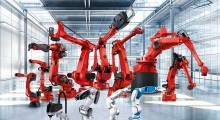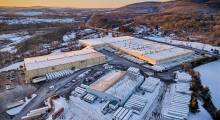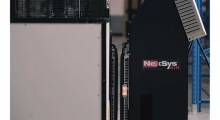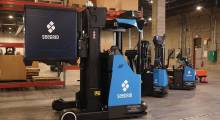There is beauty in a well-structured floral arrangement, and it often starts with foam products from FloraCraft.
The company, based in Ludington, Mich., is known as one of the top producers of foam and other products used by national retailers and wholesale florists. While FloraCraft manufactures several sizes, shapes and types of foam, as well as floral tools and containers, XPS foam is its specialty.
In 2018, the company had the chance to move into the dollar and value channel chain market, which primarily focuses on product affordability. To better meet the needs of this segment, FloraCraft sought out an automated solution for increased efficiency in its end-of-line packaging processes.
Inline flow wrappers were already being used, but boxes of foam were being packed by hand, which Steve Carlson, FloraCraft’s chief operating officer, saw as an area that could be improved by automation.
A FloraCraft team talked to a few different exhibitors at Pack Expo 2018 before deciding on a proposed solution (Brenton Engineering) based on robotics automation. This led to additional automation projects that have helped FloraCraft meet its objectives and upskill its workforce.
The beauty of the first solution revolves around flexibility. Along with reliable maneuvering of the materials, the multiple shapes and sizes of FloraCraft’s foam products made flexibility a must.
The solution features a two-robot system that went live in 2019. One overhead robot would pick the foam into a pattern, and then another robot would pick up that pattern and put it in a box. FloraCraft was able to use this solution on seven shapes and sizes of products.
After seeing impressive results of 40% more product packaged with 80% fewer labor hours through the robotic case-packing lines, Carlson noted other areas of the business that could be improved by automation. The second engagement Brenton had with FloraCraft was with a large, awkward sized foam product that needed placing onto pallets.
“Palletizing these products by hand put employees at risk for lifting and twisting injuries. Implementing a robotic system meant workers could be reallocated to jobs that reduced the risk of injury and also where their skills could be better utilized.” - Steve Carlson
The third project between the two companies added an identical line to the first solution, along with a pallet stacker. This third project went live in 2022.
Carlson cites shared values as the reasons the brands continue to work together.
“We really like the team, processes, and culture of Brenton. They lay out a practical, sound solution that makes sense for us. We’re in constant communication throughout the process, and they’re good at delivering what they promise.” - Steve Carlson
All FloraCraft’s machinery undergoes factory acceptance testing (FAT) at Brenton’s Alexandria, Minn., facility before installation. Completing the FAT ensured the solution performs to FloraCraft’s requirements prior to shipment, while also helping to train FloraCraft personnel on operation and preventive maintenance procedures.
In addition to that training, FloraCraft sent employees to programs and classes to teach them how to program robotics. This increased the skillset of FloraCraft’s workforce and its overall throughput, knowing the machines better has allowed employees to take ownership of the work and the robots.
Carlson explains that the fears of robots taking jobs eased as plans were communicated. “We’re not going to have a decrease in people, we’re going to increase training and skills in the people we already have, and our goal is to be able to grow the business at a faster rate,” Carlson says of adopting the automation.
As FloraCraft’s business continues to grow, Carlson sees increasing automation as a means to achieve long-term efficiency goals amid anticipated staff shortages. FloraCraft has recently moved a significant portion of its manufacturing from an older three-story building to a modern one-story facility more conducive for robotics. Potential new opportunities include a sideload case packer and material movement options, such as automated transport vehicles.
“The future will be a combination of automation and new people, It can’t just be new people, because of the challenges of recruiting in a rural resort town.” - Steve Carlson
Article topics










